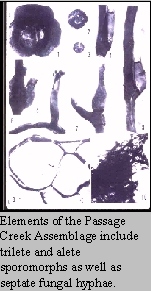
Strother et al. 1996 (Geology, v. 24, p. 55-58) have studies the Middle Ordovician shales of Saudi Arabia.
Dyads are known from Cooksonia and Rhynia-type sporangia (Fanning et al., 1991). They argue for a terrestrial origination for this assemblage; plants at a bryophyte-grade of development (permanently bound tetrads). No extant algae are known to produce either trilete spores or resistant-walled, tetrahedrally arranged spore tetrads. Earliest trilete spore in the Ashgillian (latest Ordovician). Taylor (1995) has shown that the ultrastructure of Dyadospora (Ashgillian Ohio) has a lamellated spore wall that is similar to modern hepatics.
Remains of what have been interpreted to be the earliest known vascular land plants appear in the mid-Silurian (Wenlockian). This evidence consists of spores, recovered from shallow marine environments, similar to those isolated from early land plants. Spore diversity by Late Silurian time is greater than that known from megafossil evidence. This may be due to spore release from vegetation living on better-drained soils, evidence for the parent plant not having been preserved.
Evidence for early land plants is first encountered in fluvial sediments (Massanutten Sandstone) of the Early Silurian
(Llandoverian) of Virginia. The PASSAGE CREEK ASSEMBLAGE is comprised of:

2) Cuticular and membranaceous fragments (one cell and several cells thick).
3) Alete and trilete spores and tetrads.
4) Small septate hyphal filaments and filamentous mats.
One of the earliest inhabitors of land may have been the lichen, an organism that is the symbiotic relationship between a green alga and a fungus. These organisms today colonize bare rock surfaces and are responsible for the breakdown of lithic materials via biochemical weathering. The earliest known lichen has recently been reported from the Early Devonian Rhynie Chert.
Paleosols (ancient soils) are a record of land surfaces and the vegetation that shaped their character. Plants that colonized these soils can be interpreted from root traces and soil (paleosol) profile (once diagenetic effects have been accounted for). Retallack has proposed two terms:
Polsterlands are believed to exist in the Late Ordovician of Nova Scotia and Pennsylvania (which also include abundant burrows, but no root traces). More evidence exists for the identification of brakelands. Brakelands are found as early as Late Silurian and continue into the Carboniferous. Evidence of macroinvertebrate bioturbation exists in these oxidized calcareous soils.
Greg Retallack has provided reconstructions of Past Soilscapes including Ordovician (465 Ma) paleosols from central Pennsylvania.
Pinnatiramosus from China (Cai et al. 1996) believed to be Silurian due to regional stratigraphic correlations. The "rooting" structures are 2 meters below the Silurian/Permian unconformity.
Cai et al. argue that these are SILURIAN vascular plants and, hence, the level of evolution of plant clades is higher than previously thought. Approximately >40 MY of time between Silurian/Permian; similar to that of present/Eocene. Possible that Silurian sediments were not lithified and Permian plants rooted. Rooting structures, then, may represent Permian vegetation and not Silurian.
Cooksonia has been found in the Late Silurian of Bolivia (Morel et al. 1995) at 50o - 60o South Latitude indicating that it has spread to high latitudes soon after its appearance in the Wendlockian. It is the 4th Silurian record from Gondwana: Pridoli of Libya & Pridoli of Bohemia.
Several environmental changes are noted to occur in the early Silurian (435 Ma)